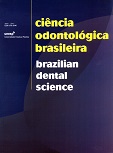Assessment of a method for dental age assessment in panoramic radiographs and its relationship with the chronological age
DOI:
https://doi.org/10.14295/bds.2007.v10i4.271Abstract
Our purpose on the present paper was to verify the reproducibility, the variability and the reliability of the analysis of the dental age (DA) and to assess its relationship with the chronological age (CA). Fifty-three panoramic radiographs from 32 female and 21 male Brazilian children, with ages ranging between 120 and 131 months were submitted to the assessment of their DA according to the general14 and the sex-adjusted15 Standards for the Chronology of Dental Mineralization by four examiners. A high intra-observer and inter-observer reproducibility was found for both sexes. The DA obtained with the general standard was lower than the CA for male and female individuals. With the sex-adjusted standard, we observed that the female individuals tend to have the DA lower than the CA. However, when the values for the CA were subtracted from the values for the DA obtained with the adjusted table, only 13.09% of male individuals and 7.03% of female individuals had the DA out of the acceptable limit of ±12 months. When the CA values were subtracted from the DA values obtained with the general standard, 4.76% of male individuals and 12.5% of female individuals were above or below the acceptable limit of ±12 months. Although the results for the differences between the DA and the CA of some examiners were statistically significant, these differences are clinically irrelevant. The dentists do not need previous experience with the method, since it is based on comparisons of the radiographic images of the teeth with standards of mineralization stages. Based on the results, we concluded that the method is highly reproducible both for the comparisons of the results of one examiner and for the comparison of the results of a group of examiners. As expected, it is applicable to the Brazilian population. The Dental Professionals do not need previous experience with the method, since it is based on the comparison of the radiographic images of the teeth with the stages of dental mineralization.Downloads
Downloads
Published
How to Cite
Issue
Section
License
Brazilian Dental Science uses the Creative Commons (CC-BY 4.0) license, thus preserving the integrity of articles in an open access environment. The journal allows the author to retain publishing rights without restrictions.
=================




























